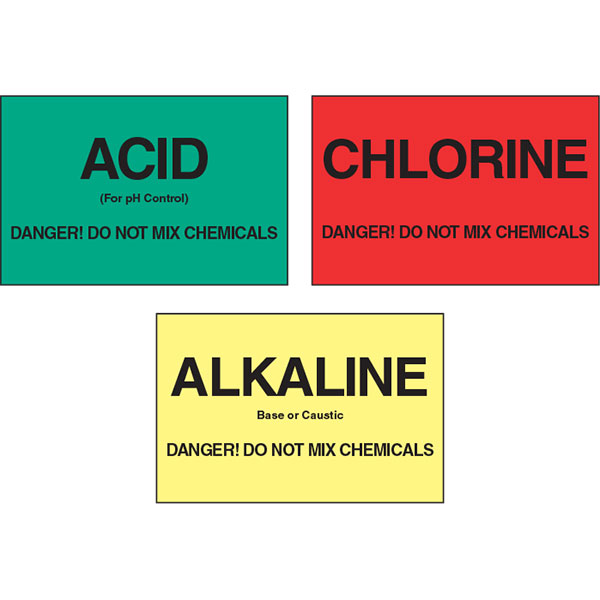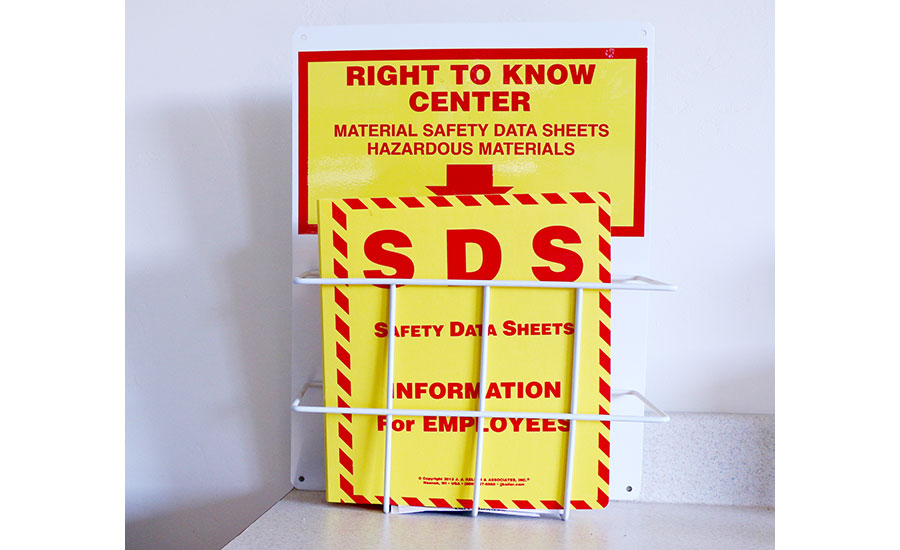44 standard labels for chemical containers
GHS Labeling Requirements: The Definitive Guide [2021 Update ... - Luminer However, the GHS takes into consideration that, sometimes, it's not possible to keep workers safe with only these six label requirements, which is why it also allows for supplemental information. 1. Product Identifier This requirement identifies the actual hazardous chemical inside the container. Hazard Communication - Container Labeling - OSHAcademy free online training The various types of container labels that will be discussed include: Primary (Shipped) container labels are found on the shipping containers and containers received for use. Secondary (Workplace) container labels are found on employer containers, such as a smaller container used to store a chemical. For example, a spray bottle containing a ...
Rules for Proper Secondary Container Labeling - HSI Storage bottles for solutions or dilutions of a chemical. Sample vials or sealable tubes. Large batches of the same compound may be labeled collectively, provided that they are stored and handled as a group. Exceptions. Only a few exceptions apply to secondary container labels. These include: If the container size is impractical to house a label.
Standard labels for chemical containers
Container Labels Reading and work safely-Safety Poster - HSSE WORLD GHS Labels for Primary Containers Primary chemical containers are the bags, barrels, bottles, boxes, cans, cylinders, and drums that you receive from the manufacturer. These containers should be labeled following the GHS mandates per the GHS label example above and include all six labeling elements. Chemical Container Labels | EHS - University of Washington The label on an original chemical container must be legible and written in English. It must include the chemical/product name as shown on the SDS and the manufacturer's name and address. Do not accept materials if the label is illegible or missing required information. (See example of original label below). PDF Chemical Labeling Guidelines - UGA Chemical Labeling Standard for Secondary Containers 7.2 References: National Research Council of the National Academies, Guide for the Care and Use of Laboratory Animals, 8th edition National Research Council, Institute of Laboratory Animal Resources, Occupational Health and Safety in the Care and Use of Research Animals, 1997
Standard labels for chemical containers. 6 Tips to Ensure GHS Compliance for Smaller, Down-Packed Chemical ... With a GHS deadline looming for industrial end users, here are six tips to quickly get up to speed on GHS regulation and ensure compliance for even smaller, down-packed chemical container labeling. 1) Have GHS-compliant safety data sheets and labels and train workers to handle hazardous chemicals properly. On each GHS label, six items of data ... 4 Quick Tips to Help You Ace OSHA Secondary Container Labeling OSHA labeling requirements for secondary containers (that do not qualify for exemption) are outlined in HazCom standard 1910.1200 (f) (6) (ii) and summarized listed below. Product Name/Identifier. This should match the product identifier on the safety data sheet. General Hazard Statement. Secondary Container Label Requirements | HCL Labels These secondary containers are required to be labeled with a GHS chemical label, given if any of the following events occur: -The material is not used within the work shift of the individual who makes the transfer. -The worker who made the transfer leaves the work area. -The container is moved to another work area and is no longer in the ... Labeling secondary containers - JJKellerSafety.com The hazard communication ("HazCom") standard at 1910.1200(f)(8) says, in part, "the employer is not required to label portable containers into which hazardous chemicals are transferred from labeled containers, and which are intended only for the immediate use of the employee who performs the transfer." If the chemical is used in the same shift ...
A Guide to OSHA's New GHS Chemical Labeling Requirements The GHS-inspired standards will require chemical manufacturers and importers to label chemical containers with 1) a harmonized signal word 2) GHS pictogram (s) 3) a hazard statement for each hazard class and category and 4) a precautionary statement. These elements are discussed in greater detail below: Chemical Container Labeling - Northwest Safety Here are some of the key requirements to be aware of: All labels must have pictograms, a signal word, hazard and precautionary statements, the product identifier, and supplier identification. Workplace labels must be provided in English. Other languages should be added to the label if applicable or necessary. Information on hazardous chemical labels | Safe Work Australia A hazardous chemical is correctly labelled if it is packed in a container and has a label written in English. Pictograms and text on the label should be clear. The label must also be firmly fixed to the hazardous chemical's container. It should not be hidden or in a spot where it could be removed, such as on the lid. The label must include the: GHS Container Labels | EHS - Anschutz Medical Campus GHS Container Labels. OSHA has adopted the new hazardous chemical labeling requirements as part of the effort to harmonize with the United Nation's Globally Harmonized System (GHS) of Classification and Labeling of Chemicals. The new label provides information to workers on the specific hazardous chemical. The container limits the label size ...
Proper Labeling Chemical Containers - Hazcom ... - OSHA Review The chemical manufacturer must ensure that primary label is marked with the following information: Product identifier - The name or number used for a hazardous chemical on a label or in the safety data sheet (SDS). Signal word - A word used to indicate the relative level of severity of hazard and alert the user to a potential hazard. GHS Labels for Secondary Containers | HCL Labels, Inc. HCL Labels, Inc. offers a library of over 800 ready-made chemical GHS labels for secondary containers. GHS-labeled secondary containers are required by state and federal law to be labeled with a GHS Safety label, indicating which chemical is in use. ... and the OSHA HazCom Standard. Have questions, custom requests, or can't find what you're ... Chemical-Resistant Labels - Vinyl for GHS | OnlineLabels.com® Label hazardous chemical containers, cartons, and drums with confidence knowing our heavy-duty, printable vinyl labels are BS5609 Section 2 GHS-compliant. This image features OL3536. No Minimum Orders ... We carry thousands of our standard label configurations in stock, offering the internet's largest selection of ready-to-ship blank labels on ... Labeling small containers | Occupational Safety and Health Administration When containers are so small that it is infeasible to include all of the HCS 2012 label elements on the label, and when the use of pull-out labels, fold-back labels, tags, or other methods of labeling are not feasible, OSHA will allow a practical accommodation for labeling.
Secondary Container Labels 101: HazCom and WHMIS - ERA Environmental In the U.S., the 2012 Hazard Communication Standard (HCS) is used and in Canada, the Hazardous Products Regulations (HPR) was established. ... Even better is to use a system that automates the entire SDS authoring and Secondary Container Label authoring - one chemical database, built-in templates, complete hazard determinations, and the full ...
Download secondary chemical container labels | EHS If your laboratory uses secondary containers filled with chemicals, the secondary containers must comply with OSHA's Hazard Communication Standard for Labels and Pictograms. For your convenience, EH&S designed secondary chemical labels that can be downloaded from our website and printed onto Avery 5163 labels. You may choose from three designs:
GHS Label Requirements, Guidelines, and Best Practices OSHA adopted GHS label requirements into their Hazardous Communication Standard (HCS) at the end of 2009. From there, it took years of work to revise regulations and implement GHS into OSHA's Hazardous Communication (HazCom) regulations. The first GHS standards were introduced in HazCom 2012, and were fully implemented by OSHA in 2016.
Everything You Need to Know About Labeling Secondary Containers - LEM Employers must ensure containers with hazardous chemicals are labeled, tagged, or marked according to OSHA regulations. OSHA states secondary labels must relate the following information: The product name The hazardous chemicals the product includes
Container Labeling: A Key to Compliance - Occupational Health & Safety Containers also must have the following identification on the container, label or tag [29 CFR 1910.1200 (f) (1)]: The identity of the hazardous chemical Appropriate hazard warnings The name and...
Chemical Safety & Identification Labels | BRADY - BradyID.com Chemical Container Labels. Chemical safety labels are used for identification of hazardous material storage, chemical containment areas and acids or solvents. Chemical identification provides the warnings and information that keep your facility and workers safe. Chemical labels can prevent injuries, costly mistakes and keep your facility in ...
Requirements for Shipped Container and Workplace Labels Requirements for Shipped Container and Workplace Labels As part of the 2012 revision of the Hazard Communication Standard, 29 CFR 1910.1200, OSHA adopted new hazardous chemical labeling requirements for shipped containers that align with the United Nations' Globally Harmonized System (GHS) of Classification and Labeling of Chemicals.
Labeling of Secondary Containers | Occupational Safety and Health ... section 1910.1200 (f) (6) (ii) requires that workplace labeling include "product identifier and words, pictures, symbols, or combination thereof, which provide at least general information regarding the hazards of the chemicals, and which, in conjunction with the other information immediately available to employees under the hazard communication …
Container Labeling | Office of Environmental Health and Safety | ECU Labels of incoming manufactured products or chemicals must contain 6 key elements: Signal Word Pictograms Manufacturer Information Precautionary Statement(s) Hazard Statement(s) Product name or identifiers OSHA requires that labels on incoming containers of hazardous materials must not be removed or defaced until the container is empty and rinsed.
Chemical Hazardous Waste Containers: EPA and DOT Labeling Requirements A container used for chemical hazmat onsite storage must be marked with the words "Hazardous Waste." It must also exhibit the starting date for its accumulation along with information about its contents (e.g., toxic, reactive, ignitable, or corrosive). If you're reusing a container, make sure to remove the old labels.
PDF HEALTH & SAFETY Chemical Container Labeling Hazardous chemical containers used within a Laboratory Area must follow the OSHA Laboratory Standard. Hazardous chemical containers used within a Non-Laboratory Area must follow the OSHA Hazardous Communication ... o Label the outside of the container with approximate contents if feasible or list where more information can be
PDF Chemical Labeling Guidelines - UGA Chemical Labeling Standard for Secondary Containers 7.2 References: National Research Council of the National Academies, Guide for the Care and Use of Laboratory Animals, 8th edition National Research Council, Institute of Laboratory Animal Resources, Occupational Health and Safety in the Care and Use of Research Animals, 1997
Chemical Container Labels | EHS - University of Washington The label on an original chemical container must be legible and written in English. It must include the chemical/product name as shown on the SDS and the manufacturer's name and address. Do not accept materials if the label is illegible or missing required information. (See example of original label below).
Container Labels Reading and work safely-Safety Poster - HSSE WORLD GHS Labels for Primary Containers Primary chemical containers are the bags, barrels, bottles, boxes, cans, cylinders, and drums that you receive from the manufacturer. These containers should be labeled following the GHS mandates per the GHS label example above and include all six labeling elements.










Post a Comment for "44 standard labels for chemical containers"